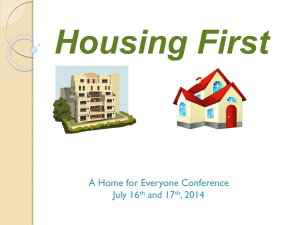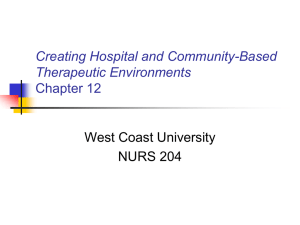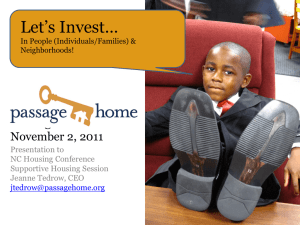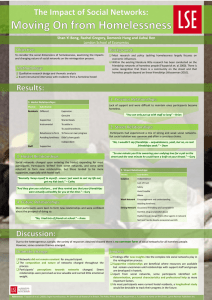Mental Health Policy – Manhattan Young Democrats
advertisement
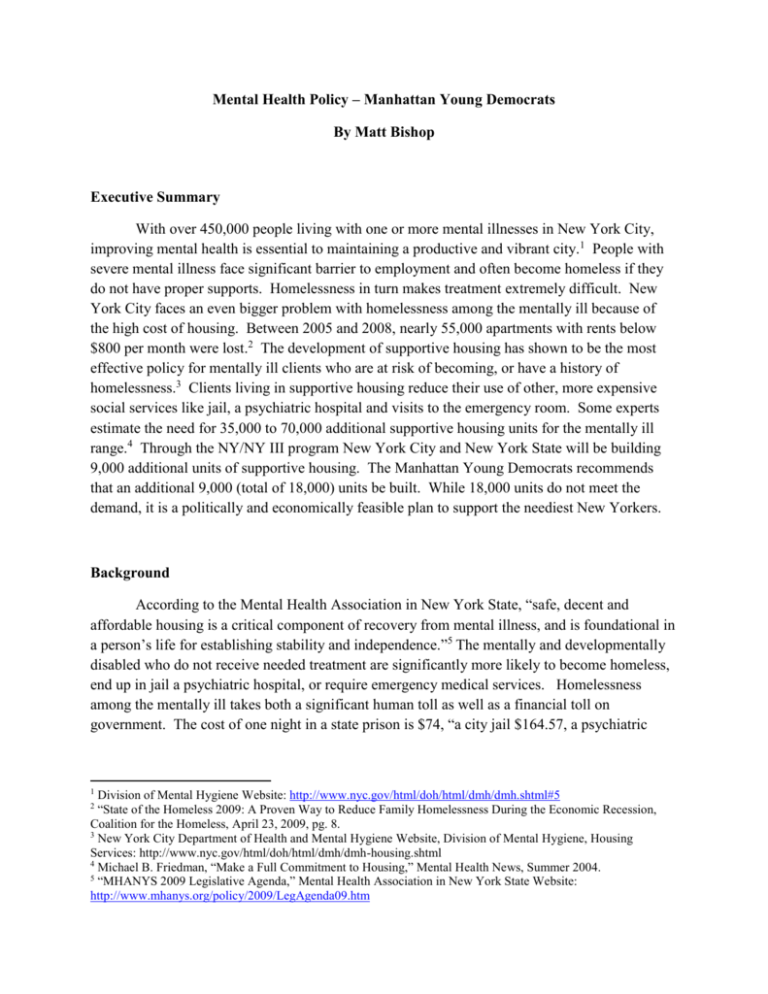
Mental Health Policy – Manhattan Young Democrats By Matt Bishop Executive Summary With over 450,000 people living with one or more mental illnesses in New York City, improving mental health is essential to maintaining a productive and vibrant city.1 People with severe mental illness face significant barrier to employment and often become homeless if they do not have proper supports. Homelessness in turn makes treatment extremely difficult. New York City faces an even bigger problem with homelessness among the mentally ill because of the high cost of housing. Between 2005 and 2008, nearly 55,000 apartments with rents below $800 per month were lost.2 The development of supportive housing has shown to be the most effective policy for mentally ill clients who are at risk of becoming, or have a history of homelessness.3 Clients living in supportive housing reduce their use of other, more expensive social services like jail, a psychiatric hospital and visits to the emergency room. Some experts estimate the need for 35,000 to 70,000 additional supportive housing units for the mentally ill range.4 Through the NY/NY III program New York City and New York State will be building 9,000 additional units of supportive housing. The Manhattan Young Democrats recommends that an additional 9,000 (total of 18,000) units be built. While 18,000 units do not meet the demand, it is a politically and economically feasible plan to support the neediest New Yorkers. Background According to the Mental Health Association in New York State, “safe, decent and affordable housing is a critical component of recovery from mental illness, and is foundational in a person’s life for establishing stability and independence.”5 The mentally and developmentally disabled who do not receive needed treatment are significantly more likely to become homeless, end up in jail a psychiatric hospital, or require emergency medical services. Homelessness among the mentally ill takes both a significant human toll as well as a financial toll on government. The cost of one night in a state prison is $74, “a city jail $164.57, a psychiatric 1 Division of Mental Hygiene Website: http://www.nyc.gov/html/doh/html/dmh/dmh.shtml#5 “State of the Homeless 2009: A Proven Way to Reduce Family Homelessness During the Economic Recession, Coalition for the Homeless, April 23, 2009, pg. 8. 3 New York City Department of Health and Mental Hygiene Website, Division of Mental Hygiene, Housing Services: http://www.nyc.gov/html/doh/html/dmh/dmh-housing.shtml 4 Michael B. Friedman, “Make a Full Commitment to Housing,” Mental Health News, Summer 2004. 5 “MHANYS 2009 Legislative Agenda,” Mental Health Association in New York State Website: http://www.mhanys.org/policy/2009/LegAgenda09.htm 2 hospital $467, and a hospital $1,185.”6 Research shows that supportive housing can reduce the number of clients requiring an emergency visits to the hospital by over 30%. When a client with mental illness or disability is in supportive housing, the average total number of visits to the emergency room is cut in half.7 Each unit of supportive housing saves government $16,282 per year in reduced demand for services.8 Current Policies and Programs The NY/NY III program, which began in 2005, is a $1 billion project between New York State and New York City that will lead to the development of 9,000 new units of supportive housing. It is part of the “United for Solutions Beyond Shelter,” a plan to end chronic homelessness. Three thousand more will be developed by the Department of Housing Preservation and Development. The Department of Health and Mental Health also runs or contracts with providers to maintain 5,300 units in supportive housing that were created during the first two New York/New York agreements.9 Alternatives Providing affordable housing for people with mental illness without the supportive services would be a less costly alternative. However, without the case management and other services provided it might drive up other health care costs, through increased visits to the emergency room, a psychiatric hospital, or jail. Another alternative would be to stop building supportive housing. This would take a severe toll on the quality of life of people who are mentally ill and lead to further spiraling health care costs. Recommendations Although the NY/NY III program represents a good step in the right direction, it does not go nearly far enough in meeting the demand for supportive housing that make treatment possible. 6 Housing Services: Department of Health and Mental Health Website: http://www.nyc.gov/html/doh/html/dmh/dmh-housing.shtml “Impact of Permanent Supportive Housing on the Use of Acute Care Health Services by Homeless Adults,” Tia E. Martinez & Martha R. Burt, Psychiatric Services, Vol. 57, No. 7, July 2006, pg. 992. 8 “Public Health in New York City Triennial Report 2004 – 2006,” New York City Department of Health and Mental Health, http://www.nyc.gov/html/doh/downloads/pdf/public/triennial_report.pdf: pg. 34. 9 “Public Health in New York City Triennial Report 2004 – 2006,” New York City Department of Health and Mental Health, http://www.nyc.gov/html/doh/downloads/pdf/public/triennial_report.pdf: pg. 35 – 36. 7 There has been no precise evaluation of the need for supportive housing since a study was conducted by the New York State Office of Mental Health in 1993. Since than approximately 9,000 supportive housing units for adults living with mental illness were created. Even going by these conservative outdated estimates, there is a shortfall of 11,000 units. Current estimates on the need for supportive housing range between 35,000 and 70,000.10 Moreover, supportive housing is also needed for thousands of homeless clients who are not mentally ill. As of August 5th, 2009, New York City had 35,673 mentally ill and non-mentally ill homeless individuals.11 New York City policymakers have made it clear that shelter is a temporary place to house the homeless mentally ill. In fact nonprofit providers are given 90 days to place a homeless client before they face financial penalties. . Many of these clients would function best in a supportive housing environment and that would only count the number of clients that are currently in the system. The homeless population represents another significant source of demand for supportive housing. Interviews with service providers illustrate the significant need for more supportive housing. Rosemary Gordon, Associate Director of Case Management at Jamaica Women’s Next Step Shelter (Volunteers of America), identified adequate access to supportive housing as her number one problem. In fact, she finds that her program and clients are competing for supportive housing with other programs within Volunteers of America.12 In order to treat clients with severe mental illness or developmental disabilities and decrease government expenditures emergency rooms, psychiatric hospitals and jails, New York City, New York State and the Federal Government should: Increase their development of supportive housing units by 9,000 units. Including the reduction in cost of services, each supportive housing unit costs $995 per year.13 Once they have been constructed the 9,000 additional units would cost under $9 million annually. At least half should be new congregate housing units. Congregate housing is designed specifically to meet the needs of mentally ill or developmentally disabled populations, with a shared common area and space case managers to meet with their clients. Scattered site housing is the standard housing market and it relies on case managers to make site visits. Landlords are often resistant to the idea of housing clients who are mentally ill or developmentally disabled.14 This challenge compounds with a tight housing market in New York City to make it more difficult to find scattered site housing for clients who are mentally ill. Michael B. Friedman, “Make a Full Commitment to Housing,” Mental Health News, Summer 2004. New York City Department of Homeless Services Website: 12 Interview with Rosemary Gordon, Associate Director of Case Management, Jamaica Women’s Next Step Shelter, Volunteers of America, 7/31/09. 13 “Public Health in New York City Triennial Report 2004 – 2006,” New York City Department of Health and Mental Health, http://www.nyc.gov/html/doh/downloads/pdf/public/triennial_report.pdf: pg. 35 – 36. 14 Interview with Kenya Warner, Director of Residential Services, Volunteers of America, 7/31/09. 10 11 Creating 9,000 new units is an ambitious plan to double the amount of supportive housing that is currently being developed. It is important in both the services it provides for the neediest individuals and the savings that are realized in reduced service. However, it is not ambitious enough when considered in the context of the actual demand for supportive housing: 52,500 (average of 35,000 and 70,000). Nine thousand additional units represent a compromise between what is needed and what is politically possible.

